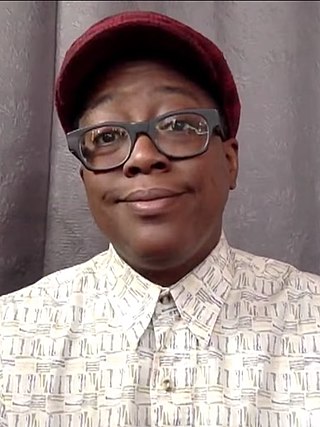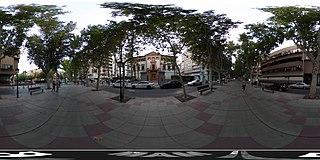Related Research Articles
In digital imaging, a pixel, pel, or picture element is the smallest addressable element in a raster image, or the smallest addressable element in a dot matrix display device. In most digital display devices, pixels are the smallest element that can be manipulated through software.

A storyboard is a graphic organizer that consists of illustrations or images displayed in sequence for the purpose of pre-visualizing a motion picture, animation, motion graphic or interactive media sequence. The storyboarding process, in the form it is known today, was developed at Walt Disney Productions during the early 1930s, after several years of similar processes being in use at Walt Disney and other animation studios.

Cinematography is the art of motion picture photography.

The PXL2000, or Pixelvision, was a toy black and white video camera, introduced by Fisher-Price in 1987 at the International Toy Fair in Manhattan, which could record sound and images onto inexpensive Walkman-style compact audio cassette. It was on the market for one year with about 400,000 units produced. After that one year, it was pulled by the market, but rediscovered in the 1990s by low-budget filmmakers who appreciated the grainy, shimmering, monochrome produced by the unit, and the way in which its lens allowed the user to photograph a subject an eighth of an inch away from the camera, and pull back to a long shot without manipulating a dial, while keeping as the background and the foreground in focus. It is also appreciated by collectors, artists, and media historians, and has been used in major films and spawned dedicated film festivals.

Sadie T. Benning is an American artist, who has worked primarily in video, painting, drawing, sculpture, photography and sound. Benning creates experimental films and explores a variety of themes including surveillance, gender, ambiguity, transgression, play, intimacy, and identity. They became a known artist as a teenager, with their short films made with a PixelVision camera that have been described as "video diaries".

Barbara Jean Hammer was an American feminist film director, producer, writer, and cinematographer. She is known for being one of the pioneers of the lesbian film genre, and her career spanned over 50 years. Hammer is known for having created experimental films dealing with women's issues such as gender roles, lesbian relationships, coping with aging, and family life. She resided in New York City and Kerhonkson, New York, and taught each summer at the European Graduate School.

Lesbian erotica deals with depictions in the visual arts of lesbianism, which is the expression of female-on-female sexuality. Lesbianism has been a theme in erotic art since at least the time of ancient Rome, and many regard depictions of lesbianism to be erotic.
This article contains a list of cinematic techniques that are divided into categories and briefly described.
Rose Troche is an American film and television director, television producer, and screenwriter.

Art of the Devil 2 is a 2005 Thai horror film directed by Kongkiat Khomsiri, Art Thamthrakul, Yosapong Polsap, Putipong Saisikaew, Isara Nadee, Pasith Buranajan and Seree Pongniti. It was released by Five Star Production.

The history of erotic depictions includes paintings, sculpture, photographs, dramatic arts, music and writings that show scenes of a sexual nature throughout time. They have been created by nearly every civilization, ancient and modern. Early cultures often associated the sexual act with supernatural forces and thus their religion is intertwined with such depictions. In Asian countries such as India, Nepal, Sri Lanka, Japan, Korea, and China, representations of sex and erotic art have specific spiritual meanings within native religions. The ancient Greeks and Romans produced much art and decoration of an erotic nature, much of it integrated with their religious beliefs and cultural practices.

Cheryl Dunye is a Liberian-American film director, producer, screenwriter, editor and actress. Dunye's work often concerns themes of race, sexuality, and gender, particularly issues relating to black lesbians. She is known as the first out black lesbian to ever direct a feature film with her 1996 film The Watermelon Woman. She runs the production company Jingletown Films based in Oakland, California.

Lesbian literature is a subgenre of literature addressing lesbian themes. It includes poetry, plays, fiction addressing lesbian characters, and non-fiction about lesbian-interest topics. A similar term is sapphic literature, encompassing works that feature love between women that are not necessarily lesbian.

VR photography is the interactive viewing of panoramic photographs, generally encompassing a 360-degree circle or a spherical view. The results is known as VR photograph, 360-degree photo, photo sphere, or spherical photo, as well as interactive panorama or immersive panorama.
Display motion blur, also called HDTV blur and LCD motion blur, refers to several visual artifacts that are frequently found on modern consumer high-definition television sets and flat panel displays for computers.
Lesbian portrayal in media is generally in relation to feminism, love and sexual relationships, marriage and parenting. Some writers have stated that lesbians have often been depicted as exploitative and unjustified plot devices. Common representations of lesbians in the media include butch or femme lesbians and lesbian parents. "Butch" lesbian comes from the idea of a lesbian expressing themselves as masculine by dressing masculine, behaving masculinely, or liking things that are deemed masculine, while "femme" lesbian comes from the idea of a lesbian expressing themselves as feminine by dressing feminine, behaving femininely, or liking things that are deemed feminine.
American Sign Language literature is one of the most important shared cultural experiences in the American deaf community. Literary genres initially developed in residential Deaf institutes, such as American School for the Deaf in Hartford, Connecticut, which is where American Sign Language developed as a language in the early 19th century. There are many genres of ASL literature, such as narratives of personal experience, poetry, cinematographic stories, folktales, translated works, original fiction and stories with handshape constraints. Authors of ASL literature use their body as the text of their work, which is visually read and comprehended by their audience viewers. In the early development of ASL literary genres, the works were generally not analyzed as written texts are, but the increased dissemination of ASL literature on video has led to greater analysis of these genres.
Girl Power is a queer feminist video made in 1992 by Sadie Benning with a Fisher-Price PixelVision camera. The video, which runs for 15 minutes, is considered at once a reflection on Benning's unhappy childhood and a celebration of her sexuality and the Riot grrrl subculture. The video was featured in "Pixel This Vision", a project organized by The Balagan Experimental Film & Video Series to "put together a program of the best of PixelVision"

Nana Darkoa Sekyiamah is a Ghanaian feminist writer and blogger. She co-founded award-winning blog Adventures from the Bedrooms of African Women and has written for The Guardian and Open Democracy. Sekyiamah is the Director for Communications manager at the Association for Women's Rights in Development and a member of the Black Feminism Forum Working Group which organised the historic first Black Feminist Forum in Bahia, Brazil.
References
- 1 2 3 Horrigan, Bill. "Sadie Benning or the Secret Annex." Art Journal 54.4 (1995): 26-29. Print.
- ↑ "The Collection | MoMA".
- ↑ "Video Data Bank: Me and Rubyfruit".
- ↑ Marks, L. "Video Haptics and Erotics." Screen 39.4 (1998): 331-48. Web.
- ↑ Spiro, Ellen. "Shooting Star: Teenage Video Maker Sadie Benning Attracts a Youthful Audience." The Advocate. 26 Mar. 1991: 68-69.
- ↑ Jutz, Gabriele (February 2017). "'Man There Ain't No Film in That Shit' Materiality, Temporality And Politics of Pixelvision Video". FKW//Zeitschrift für Geschlechterforschung und visuelle Kultur. 61: 54–71.
- ↑ Sadie Benning, “Me and Rubyfruit” (1990, 5:30) Video Works, Vol. 1
- ↑ "Sadie Benning / Me and Rubyfruit". Archived from the original on 2015-04-15. Retrieved 2013-04-26.
- ↑ Horsfield, Kate. "Busting the Tube: A Brief History of Video Art." Feedback: The Video Data Bank Catalog of Video Art and Artist Interviews. Philadelphia: Temple UP, 2006. 14. Print.
- ↑ "DVblog » Me and Rubyfruit". 3 June 2008.